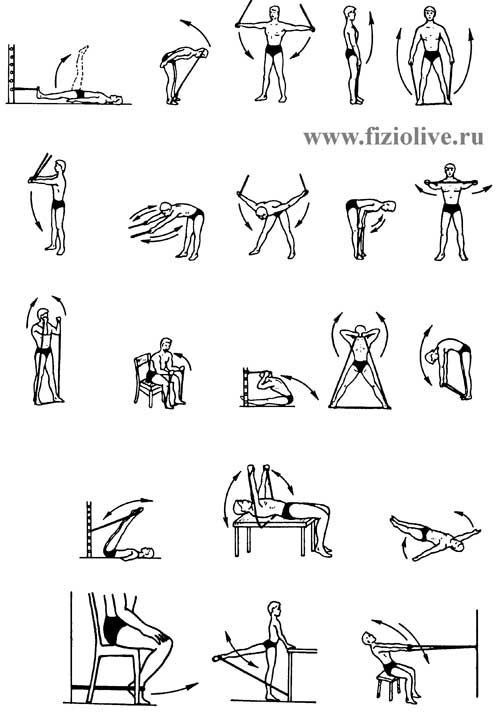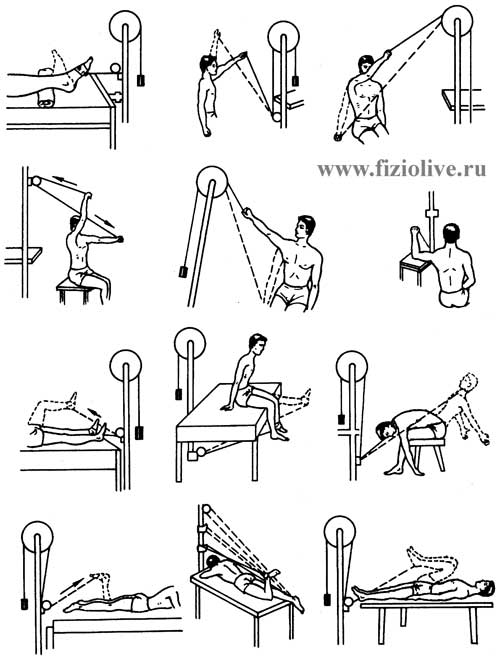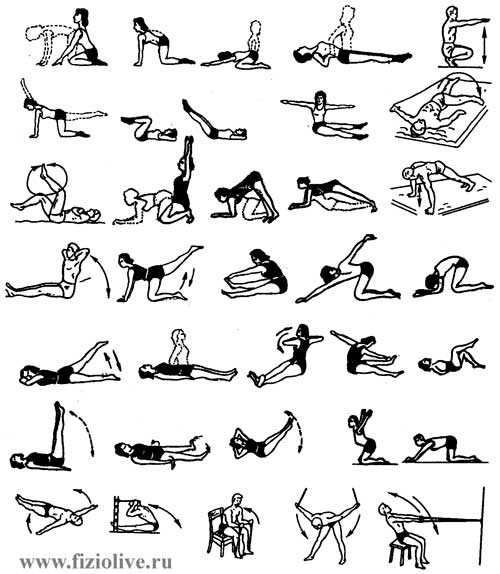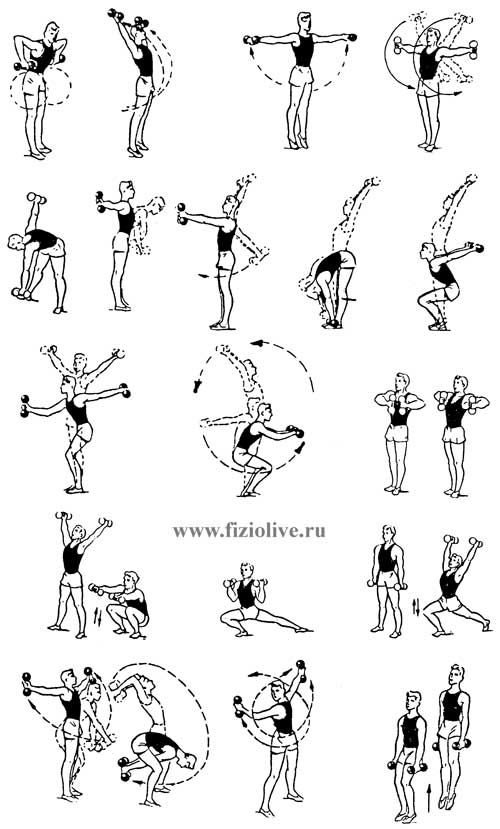
| HOME | MENU | DOCS | SEARCH |
Translations of articles in the English language
is in automatic mode, the original version
of the article in Russian - here
*Initial position - I. p.
Hypodynamia (hypokinesia) - prolonged restriction of motor activity, especially with no load on the lower limbs (walking, running, etc.), occurs in patients on long-term bed rest, long time untrained athletes (due to illness, injuries), in astronauts during flights, people with disabilities (after the lower limb amputations, cerebral palsy, paralysis, blind, etc.).
Under the influence of physical inactivity in the body there are significant changes of the Central nervous system, blood and lymph circulation, muscular system, metabolic processes, etc. All this leads to detrenirovannosti and changes in functional systems homeostasis.
Stiffness (limitation of motion) leads to reduction in the flow proprioceptive influences on the autonomic functions of many organs and systems. Decreases venous pressure, tone and muscle strength, the metabolism, which significantly changes the course of reparative processes. Violated the basic parameters of muscular activity: contractility, the ability to maintain prolonged activity, limited range of motion in joints, etc. Lack of exercise slows down the process of reparative tissue regeneration, leads to lower saturation of oxygen to tissues, venous pressure, changes in heart muscle (according to ECG) and muscle atrophy of the lower extremities in the postoperative period and a number of other diseases patients who are on inpatient treatment (Dubrovsky V. I., 1969; 1971; 1973). Studies have shown that practically no organ or system, whose functions would not have changed in the conditions of hypodynamy.
In the maintenance of homeostasis and functional condition of the organism plays a big role muscular system. Skeletal muscles not only performs locomotor (musculoskeletal) function, but has a significant impact on muscle blood flow, metabolic processes in tissues. The muscular system directly or indirectly affects the blood and lymph circulation, metabolism, respiration, endocrine balance, immunity, etc. Therefore, the restriction or absence of movements can cause disorders of physiological interaction of the organism with the external environment and give rise to a temporary functional disturbances or pathological changes in deep.
Athletes who are hospitalized after surgery on the tissues of the musculoskeletal system, changes also occur to the cardiovascular, respiratory and muscular systems, change the biochemical parameters, decreased venous pressure, disturbed microcirculation, etc.
Objectives of rehabilitation: the normalization of the functional state, metabolism of tissues and restoration of health; recovery adaptive capacity to household and industrial conditions.
It is possible to allocate two periods: the early period of readaptation and the late period of rehabilitation.
Patients undergoing the treatment, the tenth and especially on the fifteenth day a considerable loss of strength and muscle tone of the lower extremities, venous pressure, respiratory muscles, lowering blood pressure, arterial blood saturation with oxygen, the immune system (V.I. Dubrovsky, 1971, 1973, 1992).
The effect of physical exercises and workouts can be large, if training is conducted in the initial standing position (involving the support function of the lower limbs), that is, when connected to the musculoskeletal system with the loads on the reflex zones of the foot (running on a rubber track with various irregularities, the impact on the foot needle vibratone, the use of needle applicators - walking on them, the use of acupuncture on BAHT stop).
The basic principle of rehabilitation in the first period is the gradual application of the loads (initially sitting up in bed, then sitting on a chair beside the bed and exercise, then walking around the ward, then out into the street with a gradual increase in load at the walk). LH at this stage consists of General developmental exercises, exercises in the isometric lower limb muscles and training with their support functions. For example, standing and holding onto a chair, perform walking on the spot, squats and other exercises in combination with breathing exercises with small loads (monitor pulse). The repetitiveness of the exercises, their complexity should be gradual. After the patient begins to walk, all exercises should be performed only while sitting (first 3-5 days) and standing.
In an integrated system for the rehabilitation of the first period include physical therapy, segmental massage, General vibration massage, vacuum massage, exercises with rubber grommets (see Fig. Approximate set of exercises with a rubber shock-absorber), stretching exercises connective tissue formations, exercises isometric, dosed walking, climbing the stairs for 3-5 floor, running in water, training on simulators (see Fig. Approximate set of exercises at the gym), treadmill (walking and running), Bicycle, play, occupational therapy, oxygen cocktails, fortified with vitamins (especially vitamins C and b).
Approximate set of exercises with a rubber shock absorber

Approximate set of exercises at the gym

Loads must comply with functional status, sex and age of the patient. Control is carried out by pulse, test, biochemical parameters, ECG, myography, etc.
LH is not in the water, as it has no training effect, and to an even greater extent is the relaxation of the muscles, and also because a weakened body of the patient prone to colds. For the same reason, when asthenia patients should not be prescribed therapeutic baths, especially hyperthermic with various additives, since they lead to a sharp decrease in blood pressure. When low blood pressure is not shown, and a sauna (bath).
Approximate complex LH in the first period of readjustment

In the second period of rehabilitation include exercises with dumbbells, running, swimming, Cycling, skiing, classes at the gym, contrast shower, sauna (bath), diet therapy, herbal medicine, fortification, occupational therapy. Approximate dumbbell complex exercises, (see Fig. Approximate set of exercises with dumbbells during the second period of readjustment).
Approximate set of exercises with dumbbells during the second period of readjustment

At this stage, connect the hydro-Kinesis therapy (water temperature 28-30В°C) with walking in place, Jogging with the special cuffs on the ankle joints and in inflatable vests, not touching the bottoms of feet (especially important after surgery on the tissues of the ODE), games, swimming with spatulas on hand and the circles on the legs (for resistance), special exercises with dumbbells.
Duration of employment 10 to 35 min 2-3 times a day.
Approximate set of exercises:
1. Walking in flippers along the pool. In conclusion, do 2-3 breathing exercises.
2. Swimming with a Board, the legs of the inflatable ring (for resistance, greater load).
3. Swimming with spatulas, the ankle joints of inflatable cylinders.
4. Free floating H-5 min.
5. Running in place with fins of 1-2 min. Then breathing exercises.
6. Walking, Jogging on the spot and along a side, not touching the bottoms of feet. Some series, the number of which increases every 3 days.
7. I. p. - lying on your back, feet, flippers. Holding on to the side of the pool, bend and straighten leg at the knee and hip joints.
8. I. p. - the same. My footwork style "brass".
9. I. p. - the same. Bend and straighten legs, trying fingers (flippers) to touch the side of the pool.
10. I. p. - standing, water at shoulder level, the hands of a spatula. Imitation Boxing (shadow Boxing). Then perform 2-3 breathing exercises.
11. I. p. - standing in water up to his shoulders, arms to the side. To perform leg movements (walking in place with high knee lift), "pressure" on the water and quickly stand straight hands out of the water. Then free swimming and breathing exercises.
12. I. p. - standing (not touching the bottom of the pool), arms at sides. Brisk walking on the spot, hands to "draw" on the water. Then free swimming.
The third period (Spa treatment) includes sun and air baths, outdoors and in the sea, swimming, running, walking combined with Jogging on rough terrain, fortification, diet therapy, oxygen cocktail, vibration massage, sauna (bath), morning hygienic gymnastics on the beach (of the river or in the Park, the Park) followed by taking a contrast shower.
V.I. Dubrovsky,
Academician of the Russian Academy of Natural Sciences,
IANPO and the New York Academy of Sciences,
Doctor of Medical Sciences, Professor,
A.V. Dubrovskaya, pediatrician
It is available for the original version
of the article in Russian
<< Previous: Exercise therapy for injuries and diseases
We recommend that you look at the popular sections of the site myvaleology.com: MENU with a description of the sections | |||
| SOCIAL | DONATION | MY DIET | MY SPORT |

|
Release all4e8 |
||
Copyright © VZOJ 2023. All rights reserved. When reprinting or quoting myvaleology.com materials please put a link to the site myvaleology.com :
<a href="https://myvaleology.com">Healthy lifestyle</a>